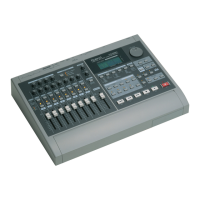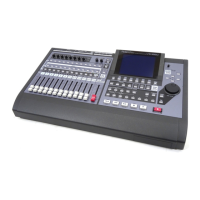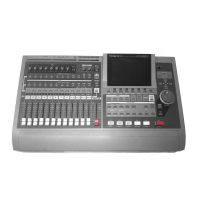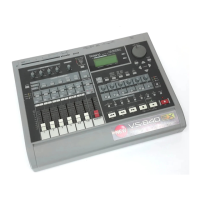9—Working with Input Signals
128 www.RolandUS.com Roland VS-2400CD Owner’s Manual
If your source material is at a higher sample rate than your project, consider converting
the external audio’s sample rate to the project’s sample rate before bringing it into the
VS-2400CD. There are various devices and utilities that you can use for this purpose.
Bit Depth
The VS-2400CD records audio using 24 bits or 16 bits, according to the project’s
recording mode (Page 93). The M24 and MTP recording modes use 24-bit resolution;
the other modes use 16-bit resolution.
If an external digital audio device uses a bit depth that’s higher than your project’s,
dither the device’s output down to the project’s recording resolution before bringing
the audio into the VS-2400CD. If the device uses the same or a lower bit depth, the
VS-2400CD will record the audio as is, at the project’s selected bit depth.
The VS-2400CD can also dither its digital output to match a lower bit depth used by an
external digital device receiving audio from the VS-2400CD—see Page 359.
The Master Clock
In order for two digital audio devices to communicate successfully, they have to both
use the same timing reference, or “master clock.” If they don’t, the digital audio they
exchange is likely to wind up at the wrong pitch, or to have clicks and pops within it.
The master clock timing reference can be produced by the device producing the digital
audio. The timing information, called “word clock,” is sent alongside the digital audio
signal from the source device—the “master”—to the receiving device, called the “slave.”
Who Should Supply the Master Clock?
There are two basic conditions in which you’ll be bringing digital audio signals into the
VS-2400CD’s digital inputs, and each has its own master clock considerations:
• when its hard disk recorder
isn’t
being synchronized to an external device
• when its hard disk recorder
is
being synchronized to an external device
When the VS-2400CD’s hard disk recorder isn’t being synchronized to an external
device, and is receiving digital audio from a single external device, use the external
device as the source of the master clock.
When the VS-2400CD’s transport is being synchronized to an external device, and is
receiving digital audio from the same device to which the VS-2400CD is being
synchronized, use the device to which the VS-2400CD is being synchronized and from
which the digital audio is coming as the master clock source. Set MASTER CLOCK to
EXT TIME CODE.
Each Roland R-BUS device has its own unique capabilities and setup parameters. The
“Supplemental Information” chapter at the end of this manual explains how to set up
each R-BUS device for use with the VS-2400CD—these instructions include details on
configuring the devices for the successful transfer of digital audio into the VS-2400CD.
VS2400OMUS.book 128 ページ 2006年2月28日 火曜日 午前11時12分

